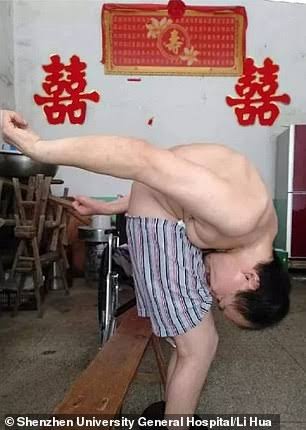
Li Hua, a 46-year-old man from China, had been suffering from a severe kind of inflammatory arthritis called ankylosing spondylitis, also known as Bechterew’s disease. This condition caused the spine and large joints to fuse, resulting in a reduction in flexibility in the spine and making it difficult for individuals to stand up or move properly. The inflammation also caused the bone to weaken, and the body produced extra calcium to grow more bone, connecting joints that aren’t supposed to be connected. Li Hua’s condition had worsened over the years, resulting in three parts of his body being connected, resulting in a fold – his chin to his chest, his breastbone to his pubic bone, and his face to his thigh bone.

Li Hua’s mother, who is now 71 years old, had been taking care of him for nearly 28 years and had tried several treatments, but none worked for Li Hua. Finally, he was taken to the Shenzhen University General Hospital, where Tao Huiren was the doctor looking after Li Hua and his treatments. He analyzed Li’s condition and took two weeks to work out a plan of action. According to the doctor, being in this folded condition could put his life in further danger as it could lead to organ failures, and this surgery was equivalent to climbing Mount Everest. Therefore, the surgery was a non-negotiable, and the doctor planned four massive surgeries that involved breaking the existing deformed bones and reconstructing them to help him stand up and maintain his posture.

The risk involved in the surgeries was pretty high, as it could result in Li Hua becoming paraplegic, undergoing hemorrhagic shock due to extreme blood loss, or even dying during the surgery. The surgeries involved experts from various fields, including anesthesiology, orthopedics, and infectious diseases.

The first surgery was a Femoral Osteotomy, which involved breaking and reconstructing Li Hua’s thigh bones, allowing the space between his face and thighs to increase. This surgery took three hours. After this, doctors conducted Cervical Osteotomy, which involved breaking and reconstructing his cervical spine, helping him to lift his head. This surgery took six hours. The third surgery was Lumbar Spine Osteotomy, where doctors broke and reconstructed the lumbar spine to help him stand up on his own legs. This surgery took around 10 hours, but after that, he could finally lay on his back after nearly 20 years. The fourth and final surgery was a hip joint replacement to help him stand up without any support and be able to walk on his feet. This surgery took seven hours.

While the surgeries were now completed, the next stage was rehabilitation, which involved physiotherapy. In the 28 years of his condition, Li Hua’s muscles had shrunk considerably, and physiotherapy was crucial to bring him back on track. After nearly a year of staying away from his home and undergoing treatments at the hospital, Li Hua was finally ready to face the world on his two legs. Thanks to the dedicated team of doctors at the Shenzhen University General Hospital, Li Hua could finally stand once again.
